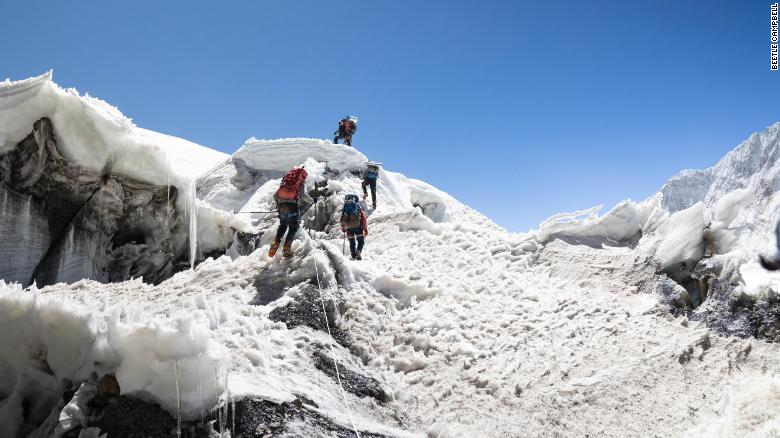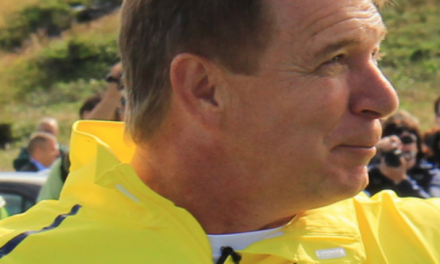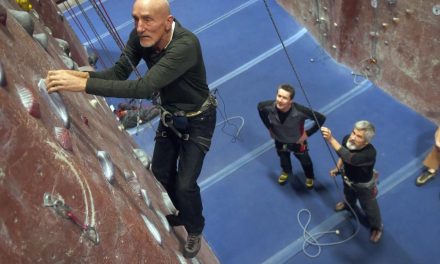Jackson was attempting to scale Himlung Himal, a 7,126-meter peak in Nepal close to the Tibetan border.
His team had been missing on the mountain for two days at the start of April, and the situation had become so desperate that prayer flags had been put out in their honor back at Base Camp.
“You reach a level of fatigue where you’re not thirsty or hungry anymore because your body’s just trying to survive,” Jackson recalls.
“It’s just concentrating on keeping your organs going … In that moment, you’re just doing everything you can to survive. You become a little bit delirious at times.”
That night on the mountain was not the first time Jackson had strayed perilously close to death.
Five years ago, while still a professional rugby union player, he dived into a shallow pool on a hot day and broke his neck.
“I was resuscitated three times. You know, I died three times in the ambulance after my accident,” he says.

Jackson used specially adapted kit from Berghaus.
Once he had regained consciousness, Jackson found himself paralyzed below the shoulders and was told by doctors that he was likely facing life in a wheelchair, probably without the use of his arms. He was forced to retire from playing rugby.
“So, it was looking pretty bleak,” he says, “but I got very lucky and there was enough of my spinal cord still attached that I started to make a recovery.”
Jackson left hospital four months after his accident and started transitioning out of his wheelchair two months later.
Then, to mark the one-year anniversary of his accident, Jackson set himself the goal of climbing Mount Snowdon — the highest mountain in Wales at 1,085 meters — even though he was still using two crutches at that time.
“I got hooked on mountains after that and was just looking for the next highest one and the next highest one. Four years later, I find myself in the Himalayas.”
‘The most remote sort of places you could imagine’
By summiting Himlung Himal, Jackson and Ben Halms — a former paratrooper who had also suffered a severe spinal cord injury– aimed to a set a new world record for the highest ascent by a person with a spinal cord injury, which previously stood at 6,500m.
Situated in an isolated corner of Nepal, any attempt to climb the mountain’s snow-capped peak is complicated by the glacier that flows down its slopes.
Due to the Covid-19 pandemic, nobody had climbed Himlung Himal for two-and-a-half years.
Confronted by unfavorable snow conditions, Jackson and his team had to navigate difficult routes across the glacier, setting up camps as they went.

The team were the first to climb the mountain since 2020, and so had to fix lines and set up camps which would normally have already been established.
It was a three-week trek in all — a week’s walk to base camp from the nearest road followed by two weeks on the mountain itself.
Far removed from any reliable source of food, on one day they “ate leftovers of a yak that had been killed by a snow leopard the day before.”
In such conditions, removed from the technologies and problems that clutter everyday life, Jackson forged a connection with his team, their Nepali guides, and the surrounding mountains.
“You feel so small among these giant things that your brain can’t really comprehend,” he says.
“When you’re in front of an 8,000-meter peak, it makes you feel tiny, but in a weirdly freeing way because it makes all your problems feel tiny as well, and it gives you a sense of place in the world.”
‘Digging in’
Jackson and his team were unable to set up the third camp, forcing them to embark on a mammoth, 36-hour summit day with 1,200 vertical meters still to climb.
“We got to about 6,800m, which is a new record,” he says.
“But we had to turn around to come back and by the time we got back down, the snow conditions had changed. Our guide fell through a crevasse.”
Trapped and surrounded by crevasses, the group called for a helicopter rescue. As the evening darkened, however, it became too dangerous for a helicopter to take flight, leaving the group to “dig in” and survive that night on the mountain.
In the morning, a helicopter picked its way through the mountain peaks and collected the stranded group one-by-one to transport them back to base camp.
Aiming to summit a mountain, Jackson suggests, is like the goals that drive quotidian life such as targeting a promotion, a new house, or a new car — important for the journeys and experiences it provokes rather than its mere, sometimes overwhelming, existence.
“The magical things I remember were those nights in camp laughing and singing with our Nepali guides or sat around a kitchen fire, which was just a hole in the floor, eating snow leopard leftovers,” he says.
One of the mountaintop villages that the team visited on their climb was so remote that its existence was only discovered 30 years ago.
“It’s things like that that we would have never experienced if we didn’t have this goal of reaching the summit. But actually, it’s not about reaching the summit.”
‘Going back to where we’re supposed to be’
Finding this sense of perspective in the mountains has allowed Jackson to begin to recover from his traumatic accident in 2017.
“Just being outside in nature is incredibly healing,” he says, “I think the silence, unplugging from reality for a while, giving yourself the headspace to think, just be, and go back to where we’re supposed to be as human beings … has been really important.”
The physical challenges of mountaineering also gave Jackson “something to aim for” as he sought to manage the effects of his accident.
“I’m classified as an incomplete quadriplegic,” he says.
“I don’t have good movement down one side of my body, no sensation down the other. And these are lifelong things that you have to stay on top of … or you will start to go the other way.”
As Jackson found healing in the mountains, he realized that others might, too. He established the charity Millimeters to Mountains (M2M) with his wife, Lois, and friend and fellow former rugby player, Olly Barkley.
M2M takes beneficiaries who have suffered physical or psychological trauma on challenges around the world, allowing them to access the healing power of nature.
Then, it provides a three-year development program which funds life coaching, retraining, or therapy to further aid recovery.
There are currently 15 beneficiaries in the system at M2M.
By dedicating himself to the charity, Jackson hopes to wring “enough good” from his life-changing accident to turn it into a positive event, outweighing the lingering effects it has on his daily life such as bladder and bowel issues, and falling over all the time.
“And it is materializing, which I have to pinch myself about because everything looked so bleak for so long,” Jackson says.
“I’ve been in those places where I’ve lost all hope and been in despair. And I thought there was no point in carrying on with my life because it was going to go nowhere and there was nothing left for me.
“But hopefully what I’m doing, what we’re doing with the charity and what our beneficiaries are proving is that we can give anyone the hope that they can turn their life around, no matter how bleak it might seem in that moment.”
Original article: By Issy Ronald, CNN
Additional video by CNN may be viewed at https://www.cnn.com/2022/05/24/sport/ed-jackson-himlung-himal-climb-spt-intl/index.html




